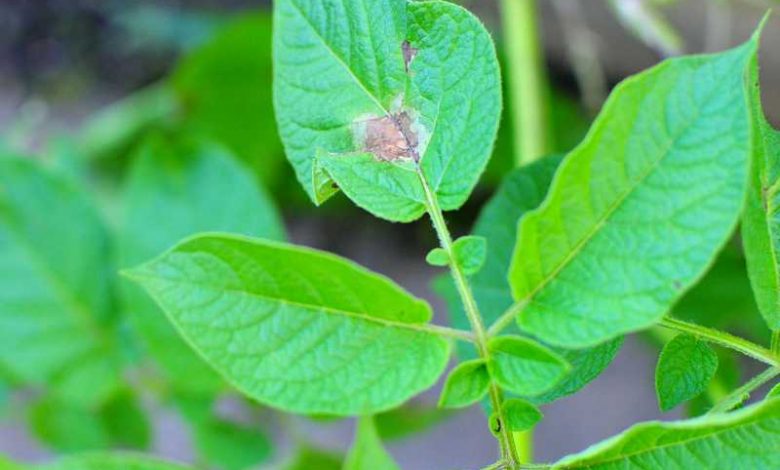
Downy mildew is, along with beetles and wireworms, one of the 3 main enemies of potatoes. In some vegetable gardens, it seems very difficult to avoid it.
Brown and dry spots
The appearance of downy mildew is manifested by small irregular yellow spots on the top of the foliage and on the stems. A white felt also sometimes covers the underside of the leaves. In the days that follow, they widen, then turn brown as they dry.
The stems also turn black very often when the disease is well advanced. The progression can be rapid so that the whole potato plant can die.
At the same time, the tubers, underground, become covered with spots, first on the surface, then in depth. They also rot and blacken.
If some of these tubers remain edible, they do not keep for long.
Phytophtora infestans
The cause of potato blight is a fungus: Phytopthora infestans. This microorganism belongs to the family of oomycetes. To develop, it likes mild temperatures (between 17 and 20°C) associated with a high level of humidity.
Potato cultivation is not the only one affected. Virtually all vegetable plants experience some form of devastating late blight . Solanaceae, such as tomato and eggplant, are also victims.
What to do against mildew in prevention?
- To strengthen the natural resistance of potatoes, regularly spray on and under the foliage a decoction of horsetail or baking soda. Renew after a period of rain or a heavy storm.
- In humid areas, choose and plant only varieties known to be disease resistant, such as Chérie or Charlotte.
- Avoid replanting tubers from previous years, they may carry fungus spores. Instead, get certified healthy tubers each year, avoiding late blight-sensitive varieties like Bintje, Amandine, Belle de Fontenay and Sirtema.
- Downy mildew is galloping if the vegetation is dense and poorly ventilated. It is therefore necessary to space the plants sufficiently apart when planting. If you don’t have enough space, choose quality over quantity!
- The soil can be a vector of disease. Crop rotation therefore plays a very important role in prevention. Do not grow potatoes two years in a row in the same place. Wait 2 or even 3 years. In addition, avoid cultivating them on a location that has hosted Solanaceae other than potatoes. Tomatoes are just as susceptible to mildew, for example, eggplant too.
If mildew appears
To save your harvest after the appearance of the fungus, the only curative treatment still possible and compatible with a way of growing organic remains Bordeaux mixture (with copper).
- Before treating, disinfect the blade of your shears then remove all the diseased parts (leaves, stems). Don’t hesitate to uproot plants that are too badly affected: they are doomed anyway and will yield nothing.
- Do not throw trash into the compost pile to avoid possible future contamination if the pile does not heat up enough to destroy the fungus spores.
- Finally, spray the Bordeaux mixture (20 g/L of water) 2 to 3 times at 4/5 day intervals.
